

LOCAL WAVESKI DEVELOPMENT
The drive to develop the sport of waveski surfing has never really died although it has gone through a slump because previous administrators either rested on their laurels when the sport was at its height, expecting the sport's inertia to take care of development or were so overworked they couldn't cope with the demands of their portfolios. Whatever the reason we now sit with the situation where most South African waveski bodies have a hard nucleus of Open and Senior category surfers and little growth in the grass-roots Cadet and Junior categories. Also, the political changes in South Africa have forced administrators to refocus on their recruitment/development strategies in view of the rather draconian regulations decreed by the National Sports Council as being a prerequisite for successful re-entry into the international arena. Put in simpler terms - No development, especially in 'previously disadvantaged communities', no play!
E.P. Waveski started a recruitment/development drive late in 1996 with mixed success. We approached disadvantaged schools and orphanages, and were pleasantly surprised by the response. The downside of this drive is that we just did not have the financial ability to keep the momentum of the exercise up, and it subsequently fizzled, not out, but very downscale. Promised financial backing by the National Sports Council, the national Waveski body (who had their own problems with development)and the Department Of Sport And Recreation never materialised.
We identified several points on which a successful recruitment/development drive could succeed:
1. Each new recruit needs his/her own equipment. Since most can't afford it, the onus rests on the organising body to provide said equipment. Waveskis, wetsuits, paddles and peripherals cost plenty. BIG problem. Donations of equipment by watersport companies is possible but they obviously expect to get some form of publicity out of it. Public exposure is a little lacking in this sport right now. Donations of old equipment, while welcome, are often rejected by the cadets, who often unreasonably expect sparkling new equipment.
2. A training manual for development. One of the easier problems to solve.
3. A set time for basic training. Since most waveski newbies are fairweather surfers and if you exclude holidays, that leaves about 2 - 3 months in the entire year for training. (Unless you live in Durban with its sub-tropical climate.) As you identify promising students you can then coax them into venturing into cold winter waters. Still, a problem. This is also where wetsuit sponsorships/donations are critical.
4. Several social events to keep interest from waning. That equates into a pretty jampacked three months of the year. Not to mention coincidental contests in this time.
5. Acquire a soup kitchen! No, seriously! With some of the disadvantaged kids, your biggest drawcard will be the attraction of a free hotdog, soda and T-shirt at the end of each event. This costs.
6. Appoint a full time recruitment administrator. Ha! In your dreams, baby! With all the waveski administrators having full time careers, that's a good one! How are you going to pay for this person? It's OK for the big sport codes, they have huge sponsorships but, for now, waveski is strictly small fry.
7. Transport: Waveskis, with accompanying peripherals, are bulky things to carry around and require a four wheeled means of transport which no Cadets have except for the forbearance of their patient parents. Those from disadvantaged surroundings do not even have this luxury and rely on dedicated adult waveskiers to fetch & carry.
These are some of the points to bare in mind. I will add more as time goes by and our experience improves. Below are some pics from a few clinics we held for kids from the MTR Smit Children's Home and other sources. Their enjoyment of the event was heartening to witness.
| 'Alright class, now pay attention!' | 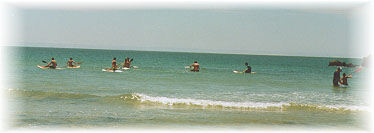 |
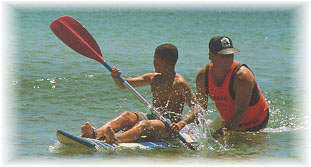 |
Marius Du Plessis gives a student a helping shove onto his first wave. |
| 'If at first you don't succeed, try, try again!' | 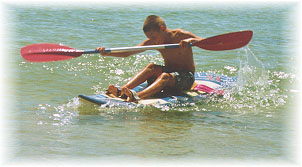 |
 |
'Aah, success at last!' |
| Craig Seale giving a couple of interested ladies, pointers on skeg positions. | 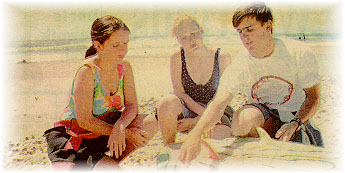 |
| Johann Momberg lectures students on surf safety. |  |
| The students get acquainted with their craft. | 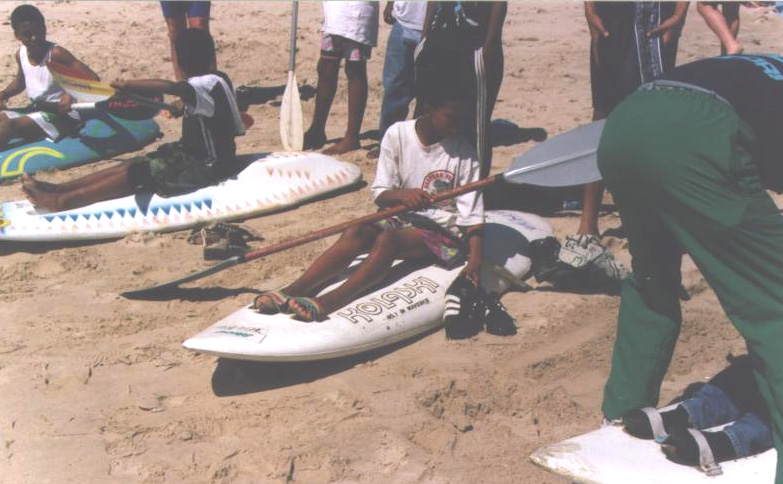 |
| Getting used to offset paddle blades often catches people out. | 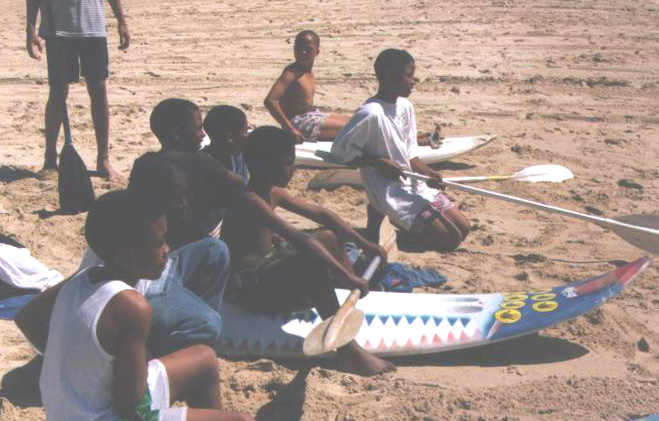 |
| �Yay, my first wave!� | 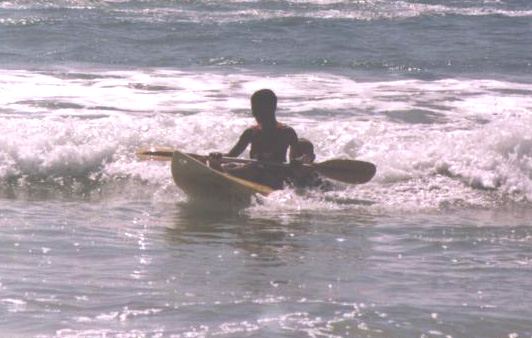 |
In spite of some of my rather negative statements above, a sport thrives on its youth and we have to encourage young people to be interested in waveski surfing, or else, waveski will become a sport practised by a few die-hard individuals. (Update: April 2001) The Sport & Recreation people have come to the table and allocated substantial funds for development and sport admin. Now, it�s up to us to produce!
If you are interested in taking up the sport of waveski surfing and you live in the Port Elizabeth area, we have created a Recruitment/Development sub-committee to drive our development program. Please give one of these people a call, even if you're not from PE, I'm sure we can put you onto the right people wherever they may be.
| NAME | TEL: (H) | TEL: (W) | FAX: | CELL: |
| Andre Rossi | 041-3793458 | 041-3732111 | 041-3735963 | 082 266 3851 |
| Naude Kotze | 041-3672726 | 041-3636912 | 041-3630504 | 082 443 4229 |
| Anton Van Schoor | ---- | ---- | ---- | 082 727 9298 |
| Homepage | Elephant | Links | Committee | Teams | Development | Breaks |
| Photos | Results | Events | Guestbook | Enrolment | Newsletters |
(Copyright - Eastern Province Waveski Association, 2002)